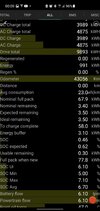Candleflame
Active Member
Simply ENVY.
I'm at 76 kWh NFP.
It seems that even if you leave your normal way to charge (AC to 55-58%) to a more stressful way (DC SuC) , you always have the better NFP ever.
I still continue to experience drops when i let the car (due to force majeure ) under 20% SOC.
Then it recovers some but not all what lost in the drop.
About balancing (going near 90% or to 100% and let it charge up to stop) I don't understand if it has something to do with IMBALANCE in SMT in mV.
I always have 4 mV imbalance ( rarely 6.00).
This means that the BMS is perfect calibrated? What the relation between the Imbalance shown and the BMS being not accurate/calibrated?
And the BMS (Battery Management System) is Calibrated or Balanced? OR are the cells to be Balanced?
If at 4.00 mV this means that theere is no room for improvement?
Curiously... just after a 100% prolonged charge (up to complete Stop) the imbalance on SMT is Higher in my car
Bms calibration has nothing to do with cell imbalance. In theory the way to check how calibrated the bms is, is to discharge the battery to 0% or better sub 0% (and enter the buffer) and look at the cell voltage and if it corresponds with the soc.
I dont think there is any point to do this though as the bms is very accurate and even gives you a confidence interval (seen in smt as soc max soc min - the bms is close to 100% sure that the soc is between soc min and soc max and the display soc seems to usually be a random number in between.
I. E. I have attached you this pic of me from a few days ago where i got to my nightcharger with 3kms left (increased to 4km while standing).
Soc expected is what the car shows you and that is 0.62% (gets displayed as 1%).
This doesnt include the buffer of 4.5%.so soc ui is the true soc (6.1% which actually means my buffer is 5.5% held in reserve)
The reason for that is that the bms is sure that my true soc is between 5% (4.4% buffer, probably a rounding error) and 7.1% (6.5% buffer).
It usually but not always seems to chose the soc min number to avoid letting you run out of juice if you do need to access the buffer. The other issue of course is that you might have 4.5% guaranteed buffer but if the cells are imbalanced enough that some cells are below safe voltage cutoff the car will just shut down. So its best not to go there.......



